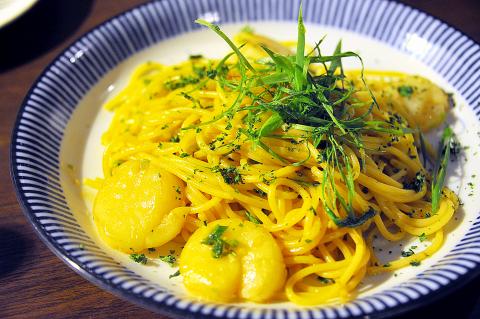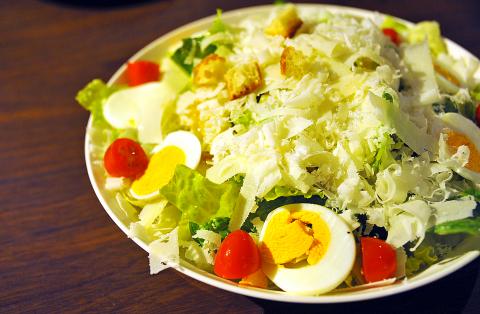Ever since my encounter with bubble milk tea pizza a few months ago, I’ve been just a bit wary of trying fusion cuisine. But when I heard that Trattoria di Primo had a cheaper, Japanese-influenced sibling, I thought I’d give it a try, as pasta has been popular in Japan since World War II, giving rise to unique creations such as spicy cod roe alfredo and the infamous Napolitan (made with ketchup).
Nagomi Pasta is nestled in a quiet alley directly east of Sun Yat-sen Memorial Hall, worlds away from the hordes of selfie-taking tourists. Its minimalist decor screams Japanese, and you almost immediately want to order some sashimi and sake until you remember that this is a pasta place.
In direct contrast to the zen-like atmosphere was the squeaky anime pop blasting in the background, which they eventually turned down (smart move).

Photo: Han Cheung, Taipei Times
The menu begins with main dishes such as grilled squid with miso sauce (NT$360), but we’re here to try the pasta, which is divided into four sections: olive oil, tomato, cream and soy sauce.
There’s a baked fusilli and rice section with intriguing items such as kimchi seafood rice (NT$380), which I’d like to come back and try.
First up was the Caesar salad (NT$160), which honestly was the best part of the meal. The portion was huge, with crispy romaine lettuce, sliced egg and tomatoes. The dressing is not your typical Caesar sauce — it’s a much lighter yolk-based concoction with garlicky undertones. There’s no cream in it, but the generous heaping of thinly-sliced, grana padano cheese gives it a kick that provides fullness of both taste and texture.

Photo: Han Cheung, Taipei Times
The fried calamari with tartar sauce (NT$200) consisted of thick, succulent slices of squid meat breaded in a way that’s closer to a Japanese tempura style, but a bit thicker, crunchy on the outside and chewy as you get closer to the meat. The sauce is sweeter and tangier than typical tartar sauce, with bits of egg mixed into it.
We ordered the butter soy sauce pasta with scallops (NT$340) and the yuzu (a grapefruit-like citrus) pepper duck pasta (NT$260). Both were pretty bare-bones, light on sauce and topped with green onions. Both dishes looked pretty similar, but the aroma was obviously different.
The buttery soy sauce provided a rich, appetizing smell before I even took my first bite. It was a bit salty at first, but the unique combination grows on you, as the richness of the butter meshes well with the savory soy sauce, enhancing the original taste of both ingredients. The scallops were tender and juicy, but most of the non-pasta texture came from the scallions. I understand the concept of minimalist pasta, but it just felt like something was missing and most of the bites consisted of just plain pasta.

Photo: Han Cheung, Taipei Times
With mushrooms and sesame seeds, the duck pasta felt more complete, but personally I liked the taste of the butter pasta more. Its definitely an intriguing dish, though, as the sauce is very layered, creating a fun flavor experience with each bite. The bitterness and slight sourness of the yuzu comes first, then the saltiness of the olive-oil based sauce, then the kick from the scallions and finally, the bold spiciness of the peppers. The duck meat wasn’t really flavored but it was juicy and had a subtle inherent savoriness, pairing well with the already complex flavors of the rest of the dish. Overall, both dishes were slightly greasy but it wasn’t too disconcerting.
As far as the entire meal was concerned, maybe a tomato pasta to go with the soy sauce one would have been a better pairing, both flavor and texture-wise, but I won’t know until I come back and try the remaining two categories of pasta.

June 9 to June 15 A photo of two men riding trendy high-wheel Penny-Farthing bicycles past a Qing Dynasty gate aptly captures the essence of Taipei in 1897 — a newly colonized city on the cusp of great change. The Japanese began making significant modifications to the cityscape in 1899, tearing down Qing-era structures, widening boulevards and installing Western-style infrastructure and buildings. The photographer, Minosuke Imamura, only spent a year in Taiwan as a cartographer for the governor-general’s office, but he left behind a treasure trove of 130 images showing life at the onset of Japanese rule, spanning July 1897 to

One of the most important gripes that Taiwanese have about the Democratic Progressive Party (DPP) is that it has failed to deliver concretely on higher wages, housing prices and other bread-and-butter issues. The parallel complaint is that the DPP cares only about glamor issues, such as removing markers of Chinese Nationalist Party (KMT) colonialism by renaming them, or what the KMT codes as “de-Sinification.” Once again, as a critical election looms, the DPP is presenting evidence for that charge. The KMT was quick to jump on the recent proposal of the Ministry of the Interior (MOI) to rename roads that symbolize

On the evening of June 1, Control Yuan Secretary-General Lee Chun-yi (李俊俋) apologized and resigned in disgrace. His crime was instructing his driver to use a Control Yuan vehicle to transport his dog to a pet grooming salon. The Control Yuan is the government branch that investigates, audits and impeaches government officials for, among other things, misuse of government funds, so his misuse of a government vehicle was highly inappropriate. If this story were told to anyone living in the golden era of swaggering gangsters, flashy nouveau riche businessmen, and corrupt “black gold” politics of the 1980s and 1990s, they would have laughed.

It was just before 6am on a sunny November morning and I could hardly contain my excitement as I arrived at the wharf where I would catch the boat to one of Penghu’s most difficult-to-access islands, a trip that had been on my list for nearly a decade. Little did I know, my dream would soon be crushed. Unsure about which boat was heading to Huayu (花嶼), I found someone who appeared to be a local and asked if this was the right place to wait. “Oh, the boat to Huayu’s been canceled today,” she told me. I couldn’t believe my ears. Surely,